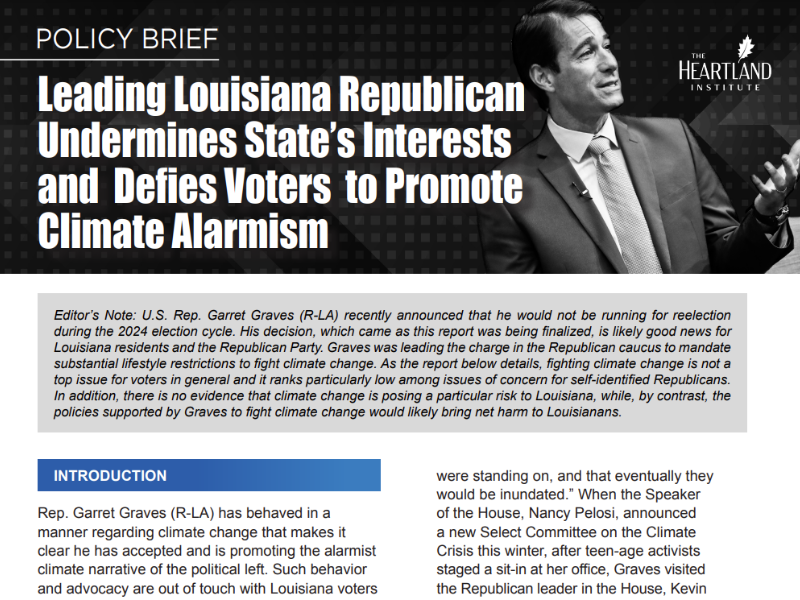History shows Earth’s climate goes through cycles, long and short, tied to a variety of natural factors. In the latter part of the 20th century, some scientists began to wonder about the causes of a modest warming, then cooling, then warming, which had been occurring since the mid-1800s. They also began to worry about the possible implications of continued warming.
Unfortunately, before scientists had gotten very far along in their research, politicians became involved, virtually destroying any chance for unbiased research.
In 1961, President Dwight D. Eisenhower delivered his now-famous farewell address warning of two dangers: the growing arms industry driven by the Cold War, which he referred to as the “military-industrial complex,” and the growing government influence over the development and use of science and technology. Eisenhower, noting scientific research was increasingly funded by governments, warned science’s aims might become corrupted. He believed science could eventually be used as a force for advancing the political aims of a scientific-technological elite. Eisenhower said, “We must also be alert to the … danger that public policy could itself become the captive of a scientific-technological elite.”
The history of governments’ involvement in climate research proves Eisenhower’s skill for predicting the future.
When the United Nations Framework Convention on Climate Change was adopted by governments in 1992, the die was cast. The convention was established on the assumption that human carbon-dioxide emissions were causing temperatures to rise to what many said were dangerous levels. The UNFCCC was established to determine ways to limit temperature increases. When the Intergovernmental Panel on Climate Change (IPCC) was formed, it was charged with understanding the human causes of climate change, not with determining the cause of warming. As the saying goes, “If you have a hammer, every problem looks like a nail,” and so it was with the IPCC. The leaders of the panel are political appointees, and each Assessment Report and Synthesis Report issued by the IPCC on the state of climate science is vetted, altered and approved by member governments.
Although the scientists working on the various IPCC reports generally do good work, when their findings conflict with the panel’s dogma about humans causing dangerous global warming, the findings are ignored, downplayed or, in the summary reports, even altered.
For instance, one section of Climate Change 1995: The Science of Climate Change: Contribution of Working Group I to the Second Assessment Report of the Intergovernmental Panel on Climate Change originally stated, “While some of the pattern-base studies discussed here have claimed detection of a significant climate change, no study to date has positively attributed all or part [of the climate change observed] to [man-made] causes.” Political intervention led to the statement being altered to read, “The body of statistical evidence in Chapter 8, when examined in the context of our physical understanding of the climate system, now points to a discernible human influence on the global climate.”
Scientists are charged with studying the human causes of climate change, but the IPCC’s “physical understanding of the climate system” is rather limited. Its own reports admit it has “low” understanding of 75 percent of the factors impacting climate change, although this hasn’t stopped the panel from having a high degree of confidence human greenhouse gas emissions drive climate change.
More recently, political leaders at the IPCC have honestly admitted the push to limit carbon-dioxide emissions is not about protecting human health or the environment; it’s about giving governments control over the world’s economy. In February 2015, Christiana Figueres, executive secretary of the U.N. Framework Convention on Climate Change, said, “This is probably the most difficult task we have ever given ourselves, which is to intentionally transform the economic development model for the first time in human history.”
Cutting carbon-dioxide emissions by 80 percent below 2005 levels, as demanded by the convention, would bring per capita carbon-dioxide emissions down to levels not seen since the 19th century, because renewables can’t replace fossil fuels and carbon-dioxide emissions can’t be captured and sequestered underground for thousands of years. That means returning emission levels to a time before cars, trucks, airplanes, computers, cell phones, refrigerators, air conditioners, heating, electric lighting, electric tools, nighttime sporting events and concerts, and the long list of other modern technologies that make life longer, healthier and more fulfilling. In short, it means forgoing the vast majority of the technological innovations that have made Western societies wealthy.
The use of coal, oil, gasoline and natural gas make modern life possible. Where fossil fuels are in regular use, people are wealthy, and where they are not used, poverty, disease and hunger are rife. Repudiating the demands of governments behind the U.N. convention will allow fossil fuels to improve the lives of billions of people by providing low-cost energy for centuries to come.
• Donn Dears is a retired senior executive at General Electric. H. Sterling Burnett is a research fellow on energy and the environment at the Heartland Institute.






